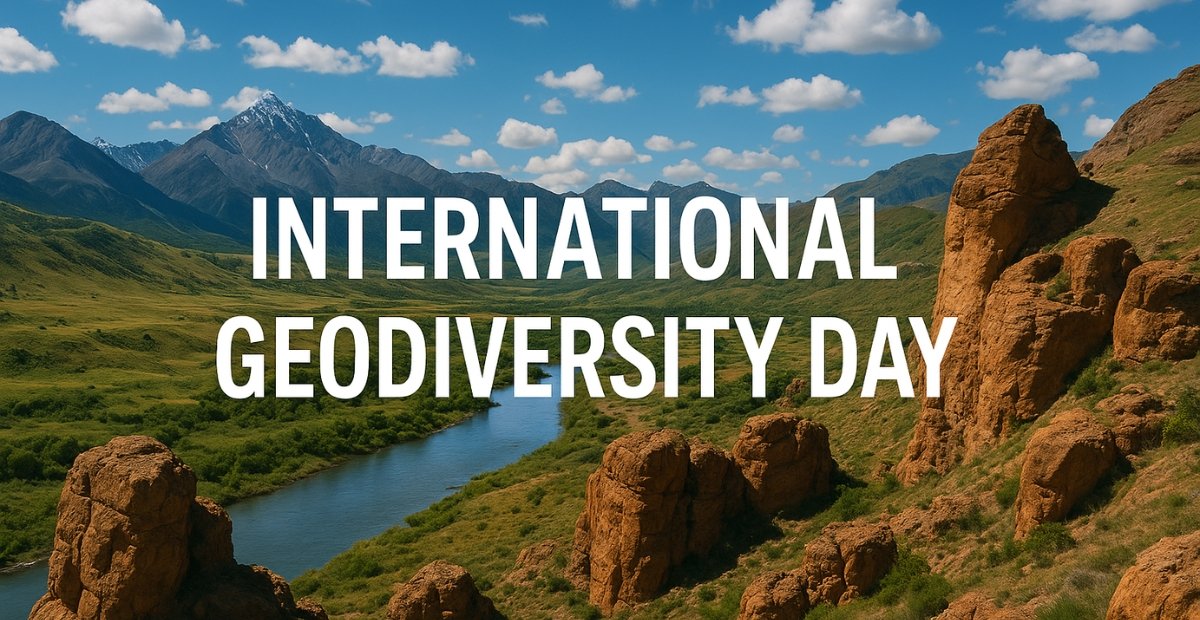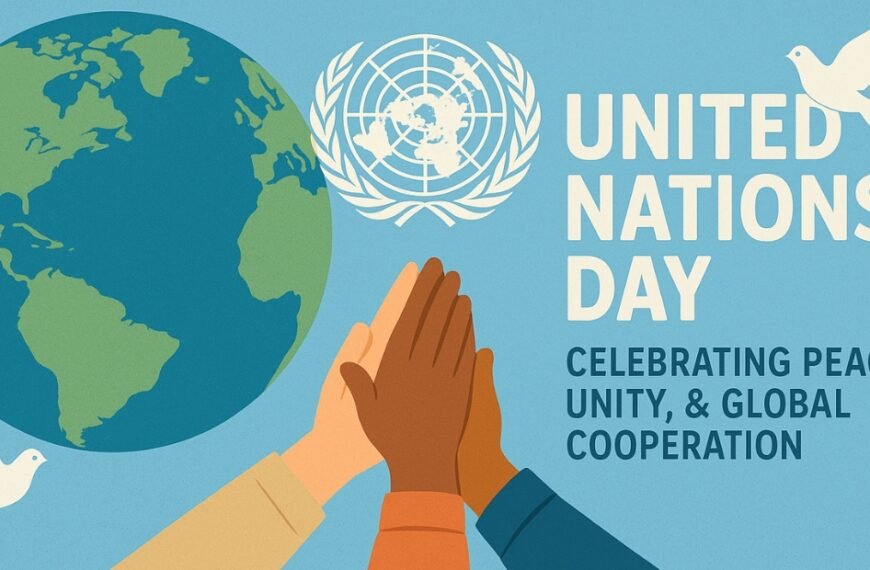Every year on October 6, the planet celebrates International Geodiversity Day, a global observance that sheds light on the different materials, landscapes, and processes that make up the Earth and the ecosystems and life forms that develop upon it. This day recognizes the foundation of all life — the natural features of our planet — and the need to protect geodiversity for a sustainable future.
Compared to geodiversity, biodiversity is more pronounced and visible to the average person. Nevertheless, geodiversity is also crucial. It impacts our soils, water, energy, and climate and the habitats for all forms of living organisms on our planet. Without geodiversity, there would be no biodiversity.
Let’s delve into our planet’s unique geological heritage and its meaning, history, significance, and how we can help preserve it. Read more: United Nations Day
What Is Geodiversity?
Geodiversity is a range of geological (rocks, minerals, fossils), geomorphological (landforms, topography), and soil characteristics and the processes that create and change these natural landscapes.
To put it another way, geodiversity is the geological architecture of the planet. It includes everything from mountains, volcanic rocks, and sand dunes to glaciers, river valleys, and oceans. It is the** non living nature** that supports life and contributes to every ecosystem.
Take a few examples:
- the grand canyon is a place where geology history of millions of years can be studied.
- the himalayas are a proof how tectonic forces are shaping the planet even now.
- the coral reefs and coastal formations are where geology and ocean biodiversity converge.
To summarize, geodiversity is the natural environment. It is a foundation without which landscapes, resources, and ecosystems could not exist.
The Origins of International Geodiversity Day
The very first advocates for a worldwide day devoted to geodiversity consisted of scientists, educators, and environmental organizations. They attempt to raise awareness on the value of Earth’s geological resources.
The initiative obtained global support following years of deliberation within the International Union of Geological Sciences (IUGS). International Geodiversity Day was commemorated for the first time during the 41st session of UNESCO’s General Conference in November 2021.
The resolution’s purpose was to:
- Advance the appreciation of the role of geodiversity in sustainable development.
- Foster education, research, and the practice of geodiversity and its conservation.
- Deepen the interconnections between geodiversity, biodiversity, and cultural heritage.
As of October 6, 2022, the global community celebrates International Geodiversity Day every year spreading the message to scientists, educators, decision-makers, and the public about the importance of the earth’s geophysical foundation to be geo-diverse.
The Importance of International Geodiversity Day
Biodiversity is constantly in the spotlight, but geodiversity is the stage on which biodiversity performs. It influences all geophysical features of the land, from the composition of the soil to the depth of groundwater, from the shape and contour of the coastlines to the health of the ecosystems.
This is the reason the observance of International Geodiversity Day is necessary:
1. It Encourages the Protection of All Components of the Ecosystem
The community knows the importance of protecting the ecosystem, the conserving of endangered species, and the preserving of biodiversity, but the protection of the earth’s geological features is equally important. Geodiversity Day clarifies to the community the steps and processes of landscape evolution, the value of rock and soil, and the role and importance of natural processes that are continuously working to support life.
2. It Supports Climate Action
Geodiversity positively affects climate regulation. Wetlands store carbon and soils absorb greenhouse gases. Natural features such as these should be protected as they mitigate climate change and enhance environmental resilience.
3. It Encourages Sustainable Development
The Earth’s geology provides our daily resources such as construction materials, groundwater, and fertile land. International Geodiversity Day Proper resource management guarantees progress without negative effects on natural systems and ensures sustainable development.
4. It Connects People to Their Heritage
Cultures, traditions, and identities are often shaped by major geographical features. Communities worldwide find the mountains, rivers, caves, and stones of their landscapes to hold historical and spiritual significance. International Geodiversity Day embodies the strong bonds between people and nature.
Geodiversity and Biodiversity: A Vital Connection
International Geodiversity Day and biodiversity are intertwined. The variety of geological features, such as landforms, soils, and minerals, determines the foundation for ecosystems.
For example:
- Lush forests are supported by rich volcanic soils.
- Unique species are supported by limestone caves.
- Marine life is protected by coastal dunes and reefs.
Destruction of geological features through mining, pollution, and erosion also leads to loss of biodiversity. Consequently, geodiversity must be upheld in order to protect the intricate life forms connected to it.
This link between life and earth systems can be exemplified through any of the UNESCO Global Geoparks and World Heritage Sites. Each of these holds priceless biological diversity and geological wonders, signifying the intertwined and interdependent nature of the various systems of the earth.
Themes of GID
International Geodiversity Day focuses on and promotes the following areas every year.
- Education and Awareness – The worth of geological heritage.
- Conservation and Management – The preservation of geologically significant areas.
- Sustainable Use of Resources – Responsible extraction and use of minerals, water, and soil.
- Cultural and Natural Heritage – The influence of geology on the formation of societies and traditions.
- International Cooperation – World nations and organizations working together to protect the planet’s foundations.
Inspires the organization of various activities, including social media campaigns.
How Geodiversity Affects People
International Geodiversity Day shapes and governs various aspects of our lives every day, whether we recognize it or not.
1. Food and Agriculture
The types of crops that can be grown in a particular area depend on the minerals and type of soil present. Farming is supported in regions such as Indonesia and Italy because of the fertile volcanic soil.
2. Water Resources
The flow of rivers and the storage of groundwater are determined by a region’s geological features. Protecting these systems and their functions is crucial for the provision of clean water.
3. Construction
The construction of buildings is based on the rocks, clay, sand, and gravel that are present in an area. For future generations, basal sustainable extraction will be necessary to maintain the form of the land.
4. Energy Sources
The various forms of geodiversity present are the reasons for the natural energy sources such as coal, oil, gas, and geothermal, as well as the other renewables. For the climate goals to be achieved, these resources must be managed well.
5. Tourism and Recreation
Numerous notable tourist destinations, including the Grand Canyon, Mount Fuji, and the Great Barrier Reef, owe their attractive features to geological formation. Geotourism is a way to fund economically and to preserve the environment.
UNESCO Global Geoparks: Protecting Geodiversity
The preservation of geodiversity relies on the Global Geoparks program. These are managed by the local populations and are of international geological importance.
With more than 45 countries, there are more than 190 Global Geoparks that function as living laboratories for the earth sciences and sustainable tourism.
These include the following:
- Marble Arch Caves Geopark (Ireland/Northern Ireland) – karst landscapes
- Langkawi Geopark (Malaysia) – tropical islands and limestone formations
- Zhangjiajie Geopark (China) – sandstone pillars
These Geoparks illustrate how the protection of geodiversity provides advantages to the local community and the environment.
Celebrating International Geodiversity Day
Celebrating this day does not require one to be a scientist; there are simple and significant ways for everyone to take part:
- Explore Nature – Go to the local mountains, parks, or beaches and observe the geological formations.
- Educate Yourself and Others – Investigate your vicinity’s rocks, soil, and landforms, and disseminate your findings on a digital platform.
- Participate in a Local Event – Numerous environmental organizations, as well as museums and schools, organize workshops and exhibitions.
- Support Conservation Efforts – Join cleanup campaigns or contribute to the protection of geological sites.
- Encourage Geotourism – Travel responsibly and keep your respect for the natural sites.
All these actions increase the awareness of the Earth’s physical diversity.
Education and the Promotion of Geodiversity
Education helps in increasing awareness on any issue, and Geodiversity is no exception. For instance, Earth systems, geology, and sustainability topics can be introduced in schools and universities.
Experiential learning opportunities, such as geological site field trips, bridge the gap between theoretical knowledge and practical application. By fostering inquisitiveness about geological processes, we shape future advocates for our planet to provide passionate stewardship for the environment.
Storytelling and other narrative techniques can also be used by teachers, scientists, and communicators to incorporate documentaries and digital media for promoting Earth science.
Conserving Geodiversity: Inherent Challenges
International Geodiversity Day In spite of the rising awareness, geodiversity is still threatened by:
- Urbanization and Land Degradation – Buildings being erected quickly disregard and demolish significant geological features.
- Mining and Quarrying – Erosion and loss of geographical areas can be a result of the aggressive extraction of a resource.
- Climate Change – Alterations of landforms are the result of rising temperatures and levels of water.
- Neglect and Lack of Awareness – Geodiversity indeed is important, and a huge portion of the population is unaware of this fact.
Enhancing these challenges is a matter of policy, education, and community engagement.
Geodiversity and the United Nations Sustainable Development Goals (SDGs)
International Geodiversity Day is associated with multiple UN Sustainable Development Goals, as with the rest of the world.
- SDG 13: Climate Action – Storing carbon and soil.
- SDG 14 & 15: Life Below Water and Life on Land – Healthy ecosystems support our goals.
- SDG 11: Sustainable Cities and Communities – Responsible urbanization.
- SDG 4: Quality Education – Earth science literacy.
This indicates that the defense of geodiversity sustains the world in all its complexities.
The Emerging Landscape of Geodiversity Conservation
Advancements in technology, such as satellite imaging, artificial intelligence, and digital modeling, are expanding the ways in which geodiversity can be studied and protected.
Nevertheless, the future of protective measures for geodiversity takes on an engaged and inclusive global outlook. To the extent that the natural heritage of the planet is to be preserved for the future, there must be cooperative efforts by the state, research constituencies, industry, and society as a whole.
From an integrated approach to protection of geodiversity, policies can be framed to prioritize strategic environmental interventions and encourage more efficient sustainable resource use.
Conclusion
International Geodiversity Day is a reminder of the diverse facets, and rich complexity, of life on Earth, and that the planet is not merely alive, but is also composed of protective and sustaining geodiversity: rocks, soils, and various landscapes. Collectively, the elements of geodiversity reflect the history of Earth from its hot beginnings to the present, flourishing world. International Geodiversity Day.
The justification for preserving geodiversity is not history for history’s sake. It is the future that we intend to provide for future generations: a future of safe and clean water, fertile soil, and mild, balanced climates.
Take a moment to reflect on the soil beneath you. On October 6, appreciate every river, every mountain, every speck of sand, and every component of Earth’s narrative.
FAQS
Why is International Geodiversity Day important?
It raises awareness about the Earth’s geological diversity and promotes the conservation of natural resources that support all life forms.
When is International Geodiversity Day celebrated?
It is celebrated every year on October 6, as declared by UNESCO in 2021.
What is the difference between biodiversity and geodiversity?
Biodiversity refers to the variety of living organisms, while geodiversity covers the variety of non-living natural elements such as rocks, soils, and landforms.


















